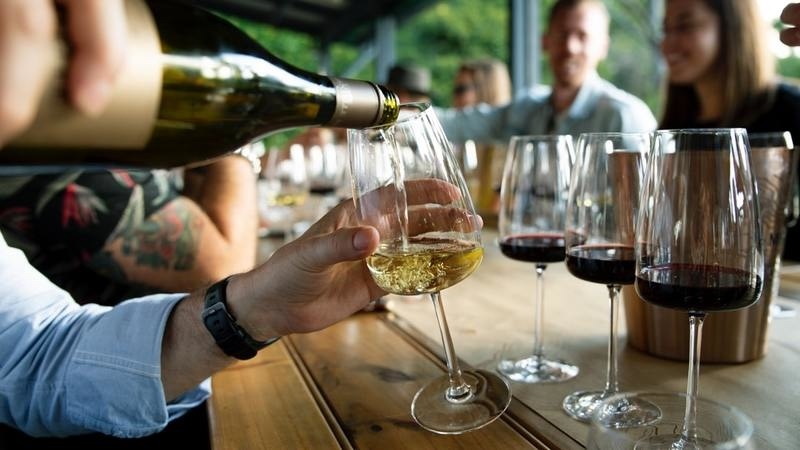
You’re planning to attend a wine tasting, and you may even be looking to invest in some wine. Wine tastings present an excellent opportunity to hone the palate and discover new varietals. How can you make the most of the experience? In this guide we’ll explore five crucial tips that will help you get the most out of your next tasting.
The Basics
Most seated wine tasting events follow a classic format you’ve likely already experienced. A typical tasting includes a flight of about five to seven wines. Depending on what’s offered, hosts usually start with sparkling wines before moving on to white wines, and then reds. If a tasting includes fortified wines or dessert wines, they will generally be offered last.
You may also find yourself at a larger walk-around styled event, with many tables and a large variety (and number) of wines. In that setting, developing a plan of attack is advisable so that you can experience all the wines you're interested in without accidentally overindulging.
A good tasting gives guests plenty of opportunity to interact with the sommelier or winemaker during the event. Follow these wine tasting tips to enhance your experience of every wine you sample.
The Tips
1. Know what (and what not) to wear.
Tastings are held at all sorts of venues, from vineyards to restaurants to outdoor festivals, so attire cues should be taken from the event’s setting. Be sure to stay away from accessories that drape or dangle, as they will increase the chance of accidentally knocking over a glass or bottle.
When it comes to clothing, keep in mind that darker options will do a better job of hiding stains.
Lastly, although it may be tempting, resist the urge to wear fragrances. An integral part of tasting wine is taking in the aroma; colognes and perfumes can interfere with your own and the other guests’ ability to smell the wines properly.
Speaking of which:
2. Smell the wines before you taste them.
Wine experts advise holding your glass by the stem, so that heat from your hands doesn't warm the wine unnecessarily. After you’ve taken an initial smell, swirl the wine gently to bring up the aroma compounds, and take a deeper inhale. Try to identify as many aromas and notes as you can. Some experts advise parting your lips or leaving your mouth slightly open to let the wine convey more aromas. For more on how to taste individual wines, check out these tips: https://www.wired.com/2016/02/how-to-taste-wine/
3. Take notes.
If you enjoy a wine, be sure to make a note of it. The more detailed your notes are, the better–it’s unlikely that you’ll remember attributes like acidity and tannin levels a few weeks after a tasting. In addition to your own observations, be sure to get down any information the tasting host offers about the wine. Make a rating system so that when it comes time to place an order, you'll know which wines you enjoyed most. If you want to get the most out of your tasting notes, you should write down your impression of each wine in five key areas:
- Sweetness: Is it sweet, or dry? If a wine makes the tip of your tongue tingle, it has a high sugar content. Some people also experience a lingering, slightly oily sensation on the tongue when tasting a sweet wine.
- Acidity: In a high-acid wine, your tongue might feel wet, or may tingle on the sides as your mouth begins to water. Acidic wines will often taste a bit tart or sour.
- Tannin: A wine with high tannin levels often leaves the mouth tasting bitter or dry. It’s easy to confuse tannins with dryness, so note that high-tannin wines generally have strong herbaceous or astringent notes.
- Alcohol: Generally, a lighter-bodied wine contains less alcohol, while a wine with a bolder profile will typically have more.
- Body: Wine body can be a challenging concept for many people to pinpoint. Simply put, it describes how a wine feels inside your mouth. Some experts compare the mouthfeel of light-bodied and full-bodied wines to that of skim milk versus whole cream. The more alcohol a wine contains, the more viscous it feels in the mouth. If the wine has a heavy mouthfeel, it’s a more full-bodied wine, while a crisper or lighter wine is more light-bodied.
4. Feel free to spit.
Understanding the characteristics of each wine as you proceed through the tasting flight requires a clear head. Spitting out wine can keep you from drinking too much too quickly, and the sommelier and other staff are well-accustomed to emptying out the spittoons.
If you sample a wine you dislike, it’s acceptable to dump out the remainder of your glass; the hosts will understand that not every wine is for you. Of course, you’re free to swallow as many tastes as you want, but keep in mind that doing this excessively at formal wine tastings is frowned upon, and it won’t help you decide which wines you want to buy.
5. Ask questions.
Many tastings offer the opportunity to meet the winemaker. This is your chance to ask questions about a wine’s cellaring potential, storage requirements, and particular information about the vintage. If you’re serious about investing in wine, ask about reserve wines not included in the flight; some events have special library wines set aside for more serious buyers.
The Reward
Once you know which wines are your favorites, it’s time to place an order. At JJ Buckley Fine Wines, is happy to offer impartial, knowledgeable advice through our consultancy service. We offer personalized attention to help you customize the best wine selection for your cellar, so you can grow your collection and get even more enjoyment out of your next wine tasting event.